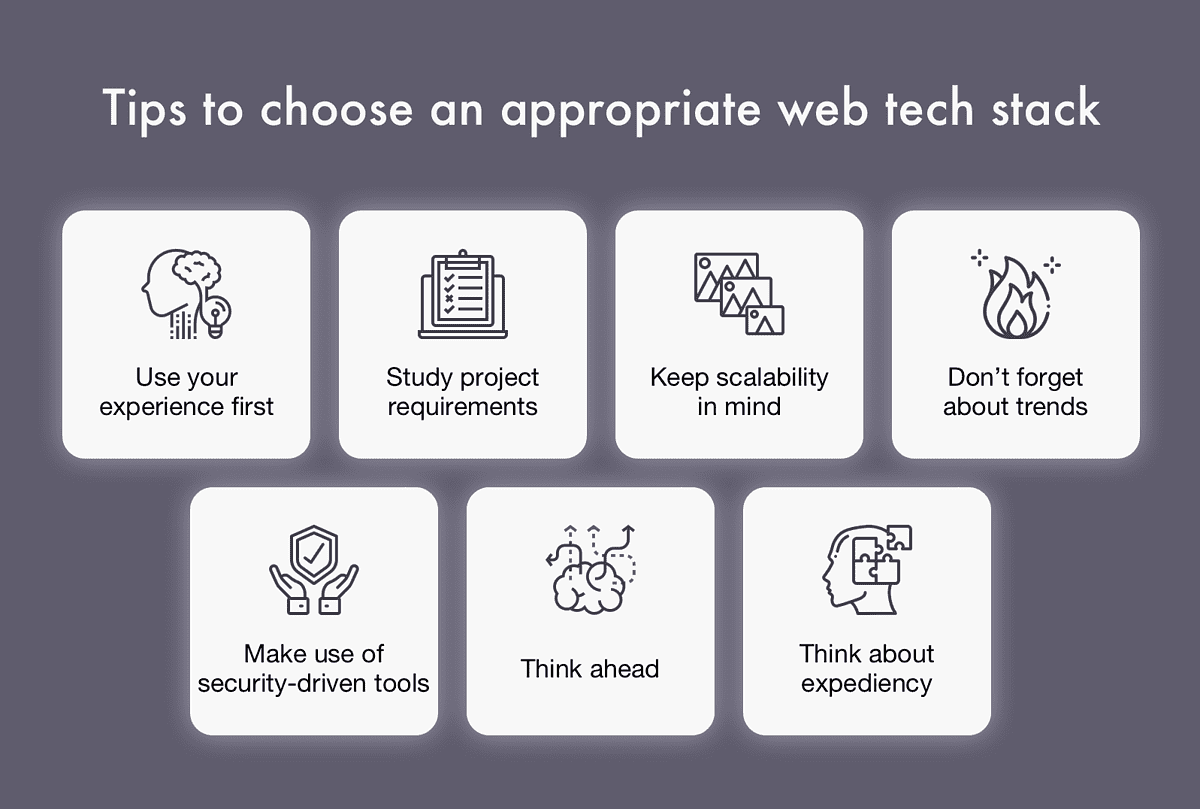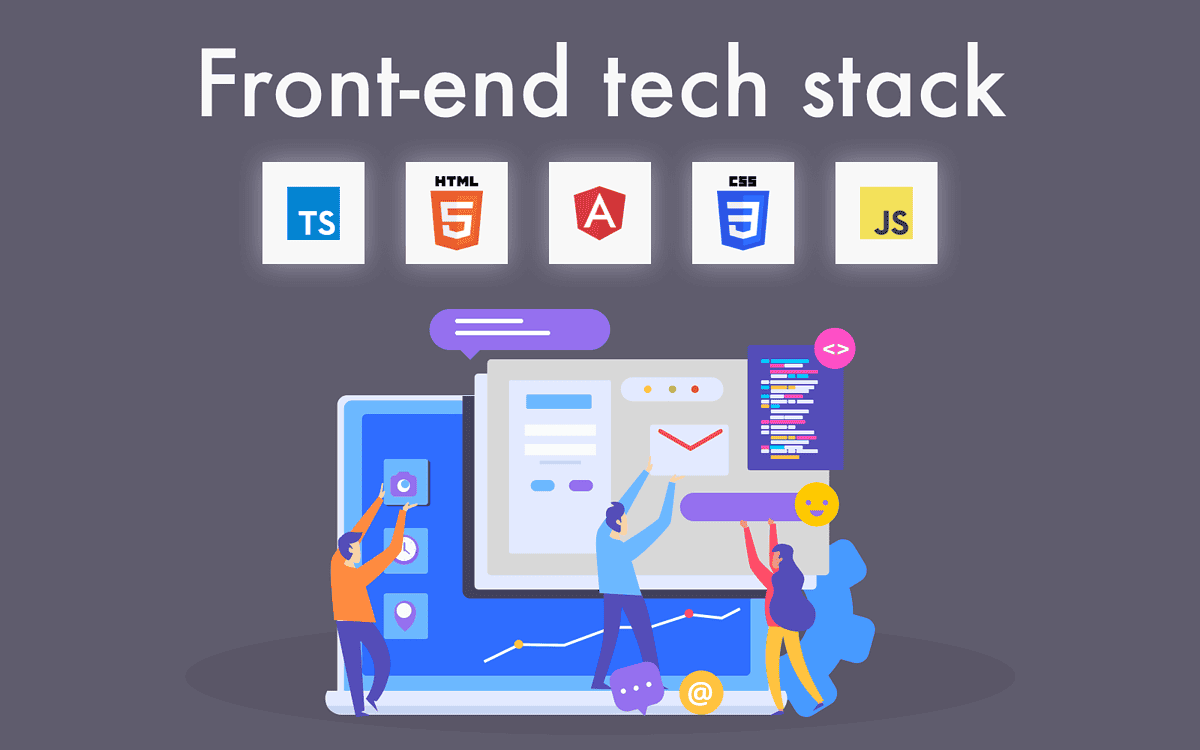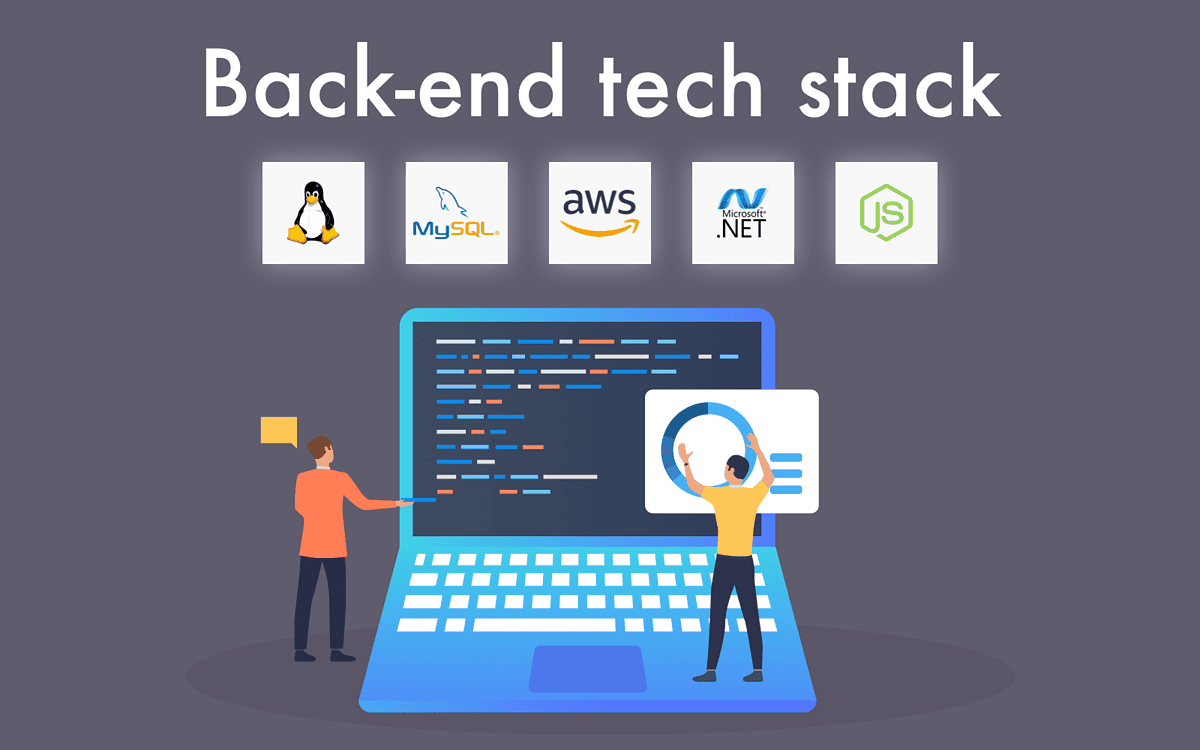Developing a website, you have to choose the appropriate web tech stack for your tech solution. The picked technologies are responsible for the website scalability. Moreover, your platform should work fast since 47% of users expect websites to load in less than 2 seconds. As you can see, there are a lot of aspects to consider while picking the web tech stack.
In this guide, we’ll discuss how to choose the right web tech stack for your project, including back-end and front-end. Also, you’ll find seven tips to use while picking the appropriate technologies.
What Is Web Tech Stack?
Firstly, let’s discuss the meaning of web tech stack.
Web technology stack stands for the combination of programming languages and different development tools like frameworks. It’s common to divide these technologies into front-end development tools and back-end development tools.
What Is Front-End Development Tech Stack?
Front-end or client-side development means the visible part of your project. Simply saying, it’s the part users can see and interact with.
Choosing the technologies for front-end development, there are a bunch of technologies to utilize:
- HyperText Markup Language or HTML
- Cascading Style Sheets or CSS
- JavaScript or JS
- SCSS
- SASS
- LESS
Of course, each development tool has a lot of frameworks. For instance, JavaScript programming language includes such frameworks and libraries as Angular, React, Vue, and jQuery.
Also, such languages as TypeScript and CoffeeScript can be used for web app development.
- TypeScript. This programming language tends to simplify the web development process since Angular (a popular front-end framework) was made with the help of TypeScript. A bunch of cool projects like Gmail and PayPal were developed with TypeScript.
- CoffeeScript. This language is famous for the ability to write more compact code.
Front-end development also requires tools for assembly. Developers tend to choose JavaScript technologies like WebPack, Gulp, and Grunt to automate routine processes.
JavaScript is one of the leading technologies for web app development (both front-end and back-end). It has a lot of frameworks, libraries, and more.
What Is Back-End Development Tech Stack?
Back-end or server-side development stands for the invisible project part. Users can’t interact directly with the server. Back-end development means creating business logic.
For example, when users fill the required form or press the button, they deal with the frontend. The backend has to check the input data and show the result, so the users can continue using the website.
The back-end part consists of a server, an application, and a database. Software developers create a project’s business logic, deploy web apps, and more on the server-side.
Since the backend consists of various elements, developers tend to use different technologies. Let’s discuss them more precisely.
- Operating system. The first step is to pick an OS for developing web apps. The most widespread operating systems are Linux and Windows.
- Web server. The server processes HTTP requests from the browser and returns the responses. Among the popular servers are Nginx and Apache.
- Databases. To process the required information (e.g. dates, geo positions), developers need to implement the database. These days, developers prefer to use MySQL, PostgreSQL, MongoDB, DynamoDB, and Firebase Database.
- Storage. AWS S3 and Firebase Storage are commonly used during web development.
- Hosting. Hosting service allows posting sites on the Internet. Developers can use services like Firebase Hosting and AWS S3 Bucket.
- Programming language. Developers write code for server-side using programming languages like C#, PHP, Ruby, Python, and more. The choice depends on the project requirements and business goals.
- Web development frameworks. Frameworks mean various tools to make the development process faster and easier. There are many popular frameworks like Laravel, Yii2, Express, and Nest.js.
What Tech Stack Should You Choose?
Understanding the basics of back-end and front-end development, let’s move on with four ready-made tech stacks.
- LAMP stack. LAMP stands for Linux (OS), Apache (server), MySQL (database), PHP, or Perl (server-side development language). Developers tend to pick the LAMP stack if they need to create a web app fast. However, this technology stack isn’t scalable and has low performance.
- Python-Django stack. Python language, in combination with the Django framework, is often used for back-end development. Moreover, web engineers utilize Apache, MySQL, or PostgreSQL.
- MEAN stack. One more abbreviation that stands for MongoDB (database), Express (back-end framework), Angular, and Node.js (back-end platforms). Mind that the chosen tools can vary depending on the project requirements.
- .NET stack. .NET is a robust framework that allows the creation of complicated web apps. C# is the primary programming language in this tech stack. .NET stack provides 60+ frameworks, several platforms, many SDKs, libraries, and so on.
As you can see, the web technology stack should consist of tools for front-end and back-end development. It’s necessary to consider your project requirements before picking technologies.
Tips on How to Choose the Web Tech Stack
Starting the project development, you need to pick the right technologies. There are several tips that can help you:

1. Experience Comes First
You should rely on your skills and experience. For example, if you have a Node.js developer in your team, it’s better to use their knowledge to develop a successful web app. To create a simple app, it’s common to choose a well-known tech stack to speed up the development.
2. Consider Project Requirements
Requirements come first and define the necessary technologies. Knowing the project complexity, you can pick technologies to scale the project easily. For example, the Angular framework is perfect for creating a one-page app. Complex project development requires using various JS frameworks, libraries, and more.
3. Take into Account the Scalability
I’ve already mentioned that your web app should be scalable. What does it mean? There are two types of scalability — horizontal and vertical. The first one stands for the capability of working on various devices. The vertical scalability provides an opportunity to add some new features or elements to a web app in the future.
To achieve great scalability, it’s better to utilize powerful programming languages like JavaScript. Such languages have various libraries and frameworks, so they are flexible.
4. Follow Trends
Trends in web development mean that a lot of specialists like certain technology. As a result, it’s easier to find a tech solution for your issues. Also, a bunch of developers have experience in trendy technologies.
5. Security Tools
Security should be your priority task. It’s required to use technologies that provide a high-security level.
This tip is especially significant if you want to integrate the payment system into your web app. Pay attention to the security issue before selecting the tool and integrate only safe ones.
6. Mind the Skills
Developers’ skills mean a lot to project development success. You need to ensure that your team has the required expertise and knowledge to integrate the chosen tech stack.
You should find and prevent challenges. It allows reducing the web app development cost and minimizing risks.
7. Keep in Mind the Expediency
Mind that you shouldn’t choose the most trendy and popular tools if your team is good at old-school but still actual technologies. Using familiar technology, software engineers can build web or mobile applications faster.
What to Consider While Picking the Web Tech Stack
Choosing the web development tech stack, you should pay attention to the project size. To give you a hint, we’ve divided projects into three groups — small, medium, and large — according to their size.
Let’s figure out the details.
- Small projects. Such projects don’t have many complicated features and can be developed faster. For instance, there can be landing pages, MVPs (Minimum Viable Products), and so on. Usually, the developers choose Python-Django or Node.js tech stack for such projects.
- Medium projects. These projects have more functions and need a more powerful tech stack. Many e-commerce projects belong to this size. To develop such an app, it’s better to use MEAN or LAMP stacks.
- Large projects. The projects of this size usually have high requirements and scalability since they manage a lot of users from all over the world. There can be social networks, FinTech software, or global e-commerce platforms. Project development takes a lot of time since the complicated tech stack and advanced features. Engineers prefer to use Angular-Node.js or Ruby-on-Rails.
The web tech stack always depends on your project requirements and business goals. It’s better to consult with qualified developers to pick the web app tech stack that fits your project.
Vitaly Kuprenko is a writer for Cleveroad. It’s a web and mobile app development company with headquarters in Ukraine. He enjoys writing about technology and digital marketing.


